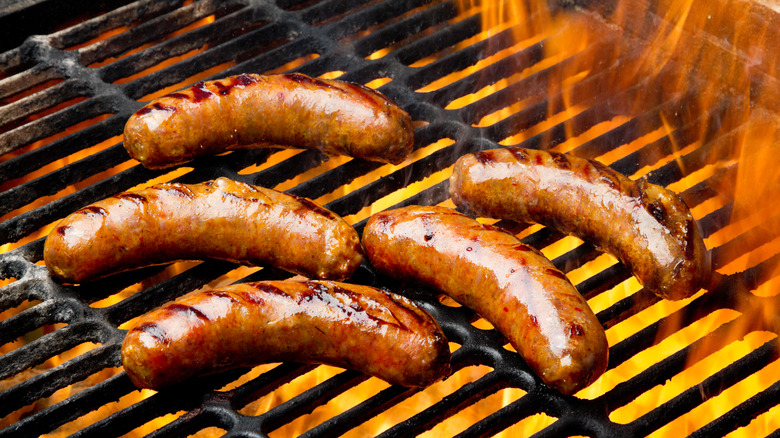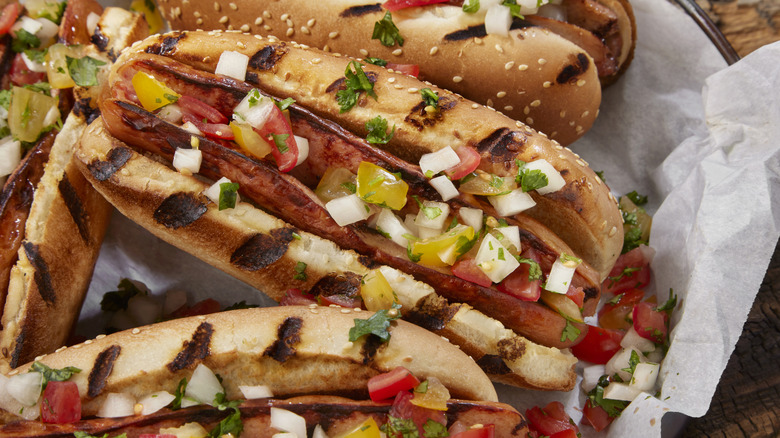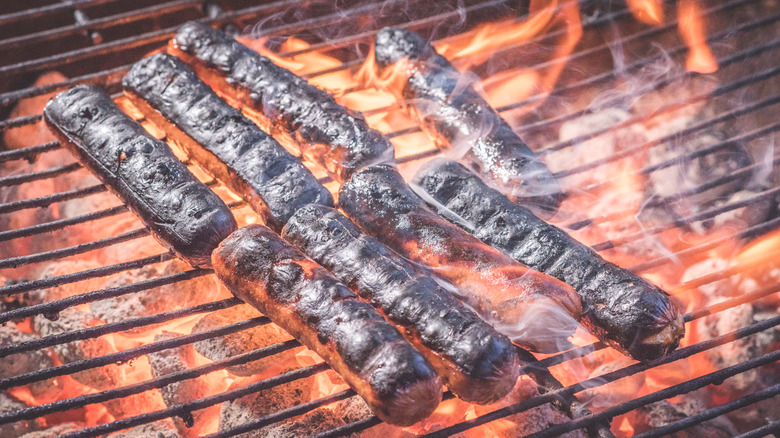For Perfectly Grilled Hot Dogs, Avoid Direct Heat
Americans absolutely love hot dogs. In fact we eat a staggering 20 billion of them a year, according to The National Hot Dog and Sausage Council, which works out to around 70 hot dogs per person. When we're not scarfing them up at baseball games, state fairs, and street vendors, there's of course plenty of hot dogs getting eaten at home. Backyard barbecues aren't complete without at least a couple of wieners because they're quick to cook, don't take up a lot of space on the grill, and when they're stuffed into a bun they're eminently portable. If you want to grill the perfect dogs, however, don't just toss them on the heat haphazardly. Hot dogs need to be cooked over indirect heat so that they don't burn on the outside and stay cold on the inside.
While you definitely want to get a few grill marks on your hot dogs to give them a little extra flavor, once you sear them it's time to transfer them over to a cooler spot on the grill. If you're not already using two-zone grilling, give it a try at your next cookout to get the perfect amount of char on your hot dogs without going overboard into charcoal territory.
Two-zone grilling
You probably don't think of hot dogs as being a delicate food item, but they're actually quite easy to overcook and burn over an open flame. While they often sit in hot water indefinitely at street vending carts, and roll endlessly around on hot rollers at convenience stores, when it comes to the grill hot dogs can suffer from direct heat.
Hot dogs are small portions of meat, typically only around an ounce and a half each, which doesn't give you a lot of leeway when it comes to cooking time on the grill. If you're cooking a batch of dogs, don't put them on the grill in the hottest spot and let them rip. The casings burn easily, and will blister crack before the insides are heated up. Instead, create two heat zones on your grill; one hot area for searing and one cooler area for heating. The hot area can be as hot as 500 degrees, which is where you can sear your dogs, steaks, and burgers. After you grill each side for a minute or two to create some grill marks, transfer your hot dogs over to the cooler zone to prevent burning, which should be around 300 degrees, and turn them frequently to cook them evenly.
Adjust your temperature for fattier dogs
If you're really into getting gourmet with your hot dogs, you can also adjust the temperature of the entire grill depending on how much fat there is in your weiners. Some dogs are much leaner than others, and you can find that information printed right on the package in the nutritional label.
Grill your higher-fat hot dogs over medium heat for the best results, while dogs with less fat (including veggie dogs and turkey dogs) are best grilled over low heat.
Most of the time when you're grilling it's not good to keep fussing with the meat while it's cooking because leaving the lid of the grill open messes with the heat. Hot dogs, however, are already cooked, you're just cooking the outside and heating the inside, so it's important to keep moving them around while they're on the grill so they don't burn. Since hot dogs cook so quickly and they need to be turned a lot, grill your other meats like steaks and chicken first with the lid closed, then put your hot dogs on last. A standard-size frank should only take 5 to 8 minutes, while a jumbo dog like Costco's can take anywhere from 10 to 15 minutes.
Even if you're using low, indirect heat, your dogs can still burn if you walk away from the grill. Keep an eye on your hot dogs and keep turning them over until they're nice and brown so that no frank gets left behind.


